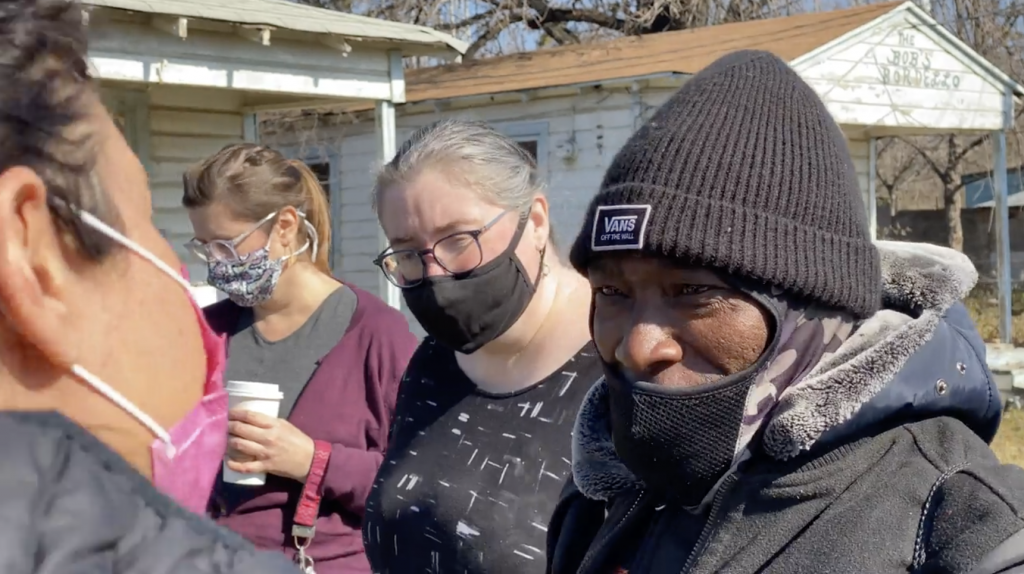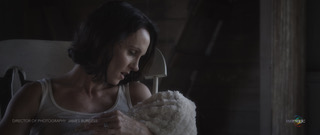Prison, news media, social justice movements: Texas filmmakers offer unique perspectives on our institutions and our lives.
ArtandSeek.net December 21, 2021 15This week’s episode of Frame of Mind revolves around Texas stories. From a documentary on newly released inmates from Huntsville Penitentiary to a video essay on the protests against police brutality in Dallas, each Texas filmmaker brings a unique vision to their stories.
Check out the list:
Huntsville Station

Still from “Huntsville Station”. Photo credit: Jamie Meltzer and Chris Filippone.
Jamie Meltzer and Chris Filippone direct this powerful 14-minute observational documentary.
Every weekday, dozens of inmates are released on parole from Huntsville Penitentiary in Texas. The camera witnesses the immediate emotions of these newly released inmates as they experience their first moments outside of prison. We watch their faces, revealing fear, excitement, and confusion. The Greyhound station serves as a limbo space for them. They’re no longer incarcerated, yet they’re not completely free either. What could be in store for them once they return to some semblance of normalcy? It’s no question that they’re wondering the same thing.
Ride A Wave

Still from “Ride A Wave”. Photo credit: George Wada.
In a whimsical production, musician Tommy Homonym performs his song “Ride A Wave” set in the original, “The Little Shop of Horrors”. Homonym weaves in and out of scenes through the use of green screen and playful video editing. He is a mere observer of the story. Homonym uses this technique to further explore the song’s lyrics, as Homonym realizes he’s been an observer in his life too. “Ride A Wave” is a song about purpose, breakthroughs, and resilience. After struggling with life’s challenges, Homonym sings that everything he needed to live a happy life was already within him. Once he finally saw the light in life, good things followed. The music video is directed by George Wada.
F News

Still from “F News”. Photo credit: Wendy Pennington.
Wendy Pennington directs this satirical movie about a teenage boy, Luke, who invents a fake news detector, playfully commenting on the absurdity of news media. Luke walks around his neighborhood in a classic salesman fashion, wearing a business suit and fake news detector in hand. Pennington plays Karen, (look out for the Karen joke), the lucky person Luke decides to pitch and sell his fake news detector to. This 7-minute short uses humor and witty writing to critique news media, capitalism, the biases and cognitive dissonance that all people possess.
Teddy’s Story

Still from “Teddy’s Story”. Photo credit: Ilknur Ozgur.
Ilknur Ozgur directs this short documentary on the remarkable anecdotes by community member, Teddy, and his experiences living in West Dallas as a young boy. Ozgur and her team at Artstillery, a performance space centered on social justice, were visiting one of the historical shotgun homes of West Dallas as part of research for their play “Family Dollar” when Teddy walked down the street and struck up a conversation with them. This documentary reveals rare stories about the once vibrant Black community on West Main Street, and the strength of that community before gentrification forced families out.
“To have Teddy just open up about how he felt growing up in West Dallas and reach such a moment of vulnerability talking about his community, I felt privileged being in that space,” said Ozgur.
Artstillery is currently developing a plan to make “Teddy’s Story” into a full-length feature documentary.
Sweeter on the Vine

Still from “Sweeter on the Vine”. Photo credit: Anna Terry.
Anna Terry directs and performs this music video showcasing a family man’s life from birth to grave. The video starts off with Terry playing piano, strings enter, then the story begins. Using flashbacks and non-linear storytelling, we watch Terry’s son grow up through the years. “I would have held him a minute more,” sings Terry as we watch her son leave home. It’s a powerful video on a parent’s process of grieving the death of their child.
How To Run In A Straight Line With Your Eyes Closed

Still from “How To Run In A Straight Line With Your Eyes Closed”. Photo credit: Christian Vasquez.
A documentary by Christian Vasquez exploring the protests of June 2020 in Dallas, sparked by the murder of George Floyd. The documentary possesses a complex narrative structure. It emulates the feeling of social movements through the use of juxtaposition. Footage from protests evokes a fast and serious tone, then it quickly transitions to moments of quiet, questions are posed to the viewer, for example, “How can you be calm when the world is on fire?” one of the questions asked. The rapid change in tone demands complete attention. In 16-minutes, the documentary not only highlights community leaders and grassroots organizations, but also analyzes the hypocrisy of civic leaders, the importance of intersectional politics, and the need to make the world better for children.










